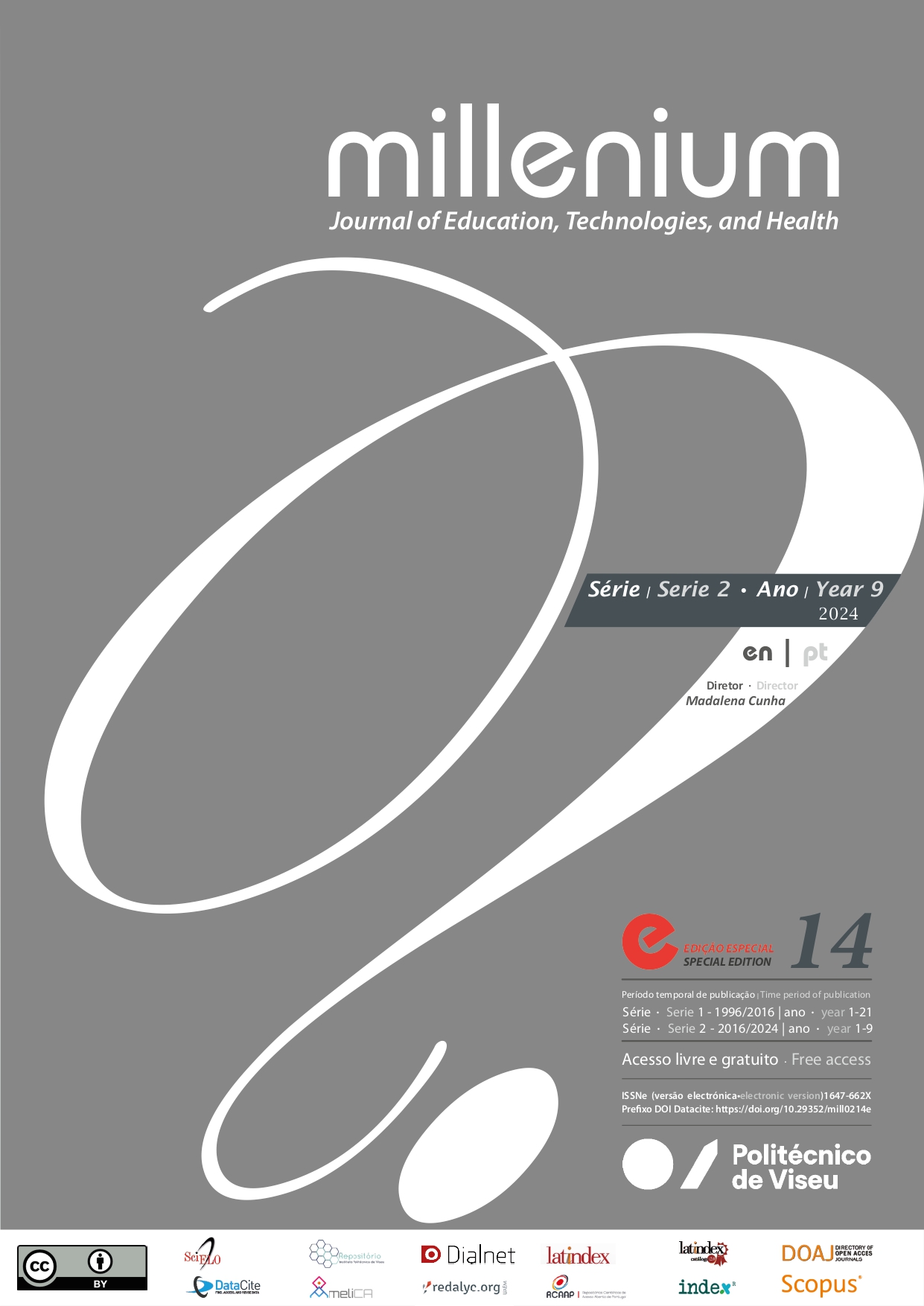A experiência dos pais sobre a readmissão da criança no serviço de urgências pediátricas
DOI:
https://doi.org/10.29352/mill0214e.34080Palavras-chave:
enfermagem pediátrica; medicina de emergência pediátrica; readmissão do paciente; mau uso dos serviços de saúde; garantia da qualidade dos cuidados de saúdeResumo
Introdução: As readmissões de crianças/jovens no Serviço de Urgências Pediátricas (SUP) com a mesma queixa da admissão inicial são cada vez mais frequentes, sendo algumas delas evitáveis.
Objetivo: Analisar a experiência dos pais em relação à readmissão da criança/jovem no SUP da Unidade Local de Saúde de Castelo Branco - Hospital Amato Lusitano (ULSCB-HAL).
Métodos: Trata-se de um estudo qualitativo, descritivo de caráter fenomenológico, sobre a experiência dos pais relativamente à readmissão da criança/jovem no SUP da ULSCB-HAL. Como instrumento de recolha de dados foi utilizada a entrevista. Os critérios de inclusão foram os pais das crianças/jovens que apresentaram episódios de readmissão nos meses de novembro e dezembro de 2022.
Resultados: A experiência dos pais relativamente à readmissão da criança/jovem no SUP da ULSCB-HAL ocorre maioritariamente devido à crença de que a situação clínica do filho não está a melhorar, ou seja, à preocupação com o estado de saúde do filho e consequente ansiedade. Destaca-se uma opinião positiva relativamente ao atendimento pelos profissionais de saúde do respetivo serviço, considerando-os atenciosos e dedicados, ocorrendo confiança nos cuidados.
Conclusão: A investigação permitiu inferir que a intervenção direcionada à redução das taxas de readmissão no SUP é bastante complexa, pois existem múltiplos fatores que estimulam ao inadequado uso do SUP.
Downloads
Referências
Akbayram, H. T., & Coskun, E. (2020). Paediatric emergency department visits for non-urgent conditions: Can family medicine prevent this?. European Journal of General Practice, 26(1), 134-139. https://doi.org/10.1080/13814788.2020.1825676
Alele, F. O., Callander, E. J., Emeto, T. I., Mills, J., & Watt, K. (2018). Socio‐economic composition of low‐acuity paediatric presentation at a regional hospital emergency department. Journal of Paediatrics and Child Health, 54(12), 1341-1347. https://doi.org/10.1111/jpc.14079
Alele, F. O., Emeto, T. I., Callander, E. J., & Watt, K. (2019). Non‐urgent paediatric emergency department presentation: A systematic review. Journal of Paediatrics and Child Health, 55(3), 271-277. https://doi.org/10.1111/jpc.14352
Bardin, L. (2016). Análise de conteúdo. Edições 70.
Fortin, M. F. (2009). Fundamentos e etapas do processo de investigação. Lusodidacta.
Gross, T. K., Lane, N. E., Timm, N. L., & THE COMMITTEE ON PEDIATRIC EMERGENCY MEDICINE (2023). Crowding in the emergency department: Challenges and recommendations for the care of children. Pediatrics, 151(3), e2022060971. https://doi.org/10.1542/peds.2022-060971
Haasz, M., Ostro, D., & Scolnik, D. (2018). Examining the appropriateness and motivations behind low-acuity pediatric emergency department visits. Pediatric Emergency Care, 34(9), 647-649. https://doi.org/10.1097/PEC.0000000000001598
Hamline, M. Y., Sauers-Ford, H., Kair, L. R., Vadlaputi, P., & Rosenthal, J. L. (2021). Parent and physician qualitative perspectives on reasons for pediatric hospital readmissions. Hospital Pediatrics, 11(10), 1057-1065. https://doi.org/10.1542/hpeds.2020-004499
Hoge, M. A., Vanderploeg, J., Paris Jr, M., Lang, J. M., & Olezeski, C. (2022). Emergency department use by children and youth with mental health conditions: A health equity agenda. Community Mental Health Journal, 58(7), 1225-1239. https://doi.org/10.1007/s10597-022-00937-7
Kurt, F., Beğde, F., Oğuz, S., Tekin, D., & Suskan, E. (2020). How important are parental age and educational level in nonurgent admissions to the pediatric emergency department?. Pediatric Emergency Care, 36(9), 414–418. https://doi.org/10.1097/PEC.0000000000001886
Martins, M., Marques, R., Sousa, M., Valério, A., Cabral, I., & Almeida, F. (2020). Frequent users of the pediatric emergency department: To know, to intervene and to evaluate - a pilot study. Acta Médica Portuguesa, 33(5), 311-317. https://doi.org/10.20344/amp.12769
McLauchlan, K., Ramlakhan, S., & Irving, A. (2019). Why do parents present to the paediatric emergency department with conditions suitable for management in less acute settings? A qualitative study. European Journal of Emergency Medicine, 27(1), 40-45. https://doi.org/10.1097/MEJ.0000000000000611
Montoro-Pérez, N., Richart-Martínez, M., & Montejano-Lozoya, R. (2023). Factors associated with the inappropriate use of the pediatric emergency department. A systematic review. Journal of Pediatric Nursing, 69, 38-46. https://doi.org/10.1016/j.pedn.2022.12.027
Rafael, M. S., Portela, S., Sousa, P., & Fernandes, A. (2017). Utilização do serviço de urgência pediátrica: A experiência de um centro português. Scientia Medica, 27(1), 1-8. https://doi.org/10.15448/1980-6108.2017.1.24919
Serviço Nacional de Saúde & Administração Central do Sistema de Saúde, IP. (2022). Circular normativa nº 11/2022/ACSS: Para: ARS, ULS, hospitais e centros hospitalares do SNS. ACSS. https://www.ulsna.min-saude.pt/wp-content/uploads/sites/7/2022/08/Circular_Normativa_11_2022.pdf
Serviço Nacional de Saúde (2023). Monitorização do SNS: Serviços de urgência. https://www.sns.gov.pt/monitorizacao-do-sns/servicos-de-urgencia/
Smyth, B. M., Ainscough, G., & Payne, J. L. (2020). Modes of communication between high-conflict separated parents: Exploring the role of media multiplexity and modality switching. Journal of Family Communication, 20(3), 189-205. https://doi.org/10.1080/15267431.2020.1754826
Zhou, H., Roberts, P. A., Dhaliwal, S. S., & Della, P. R. (2019). Risk factors associated with pediatric unplanned hospital readmissions: A systematic review. BMJ open, 9(1), e020554. https://doi.org/10.1136/bmjopen-2017-020554
Downloads
Publicado
Como Citar
Edição
Secção
Licença
Direitos de Autor (c) 2024 Millenium - Journal of Education, Technologies, and Health

Este trabalho encontra-se publicado com a Licença Internacional Creative Commons Atribuição 4.0.
Os autores que submetem propostas para esta revista concordam com os seguintes termos:
a) Os artigos são publicados segundo a licença Licença Creative Commons (CC BY 4.0), conformando regime open-access, sem qualquer custo para o autor ou para o leitor;
b) Os autores conservam os direitos de autor e concedem à revista o direito de primeira publicação, permitindo-se a partilha livre do trabalho, desde que seja corretamente atribuída a autoria e publicação inicial nesta revista.
c) Os autores têm autorização para assumir contratos adicionais separadamente, para distribuição não-exclusiva da versão do trabalho publicada nesta revista (ex.: publicar em repositório institucional ou como capítulo de livro), com reconhecimento de autoria e publicação inicial nesta revista.
d) Os autores têm permissão e são estimulados a publicar e distribuir o seu trabalho online (ex.: em repositórios institucionais ou na sua página pessoal) já que isso pode gerar alterações produtivas, bem como aumentar o impacto e a citação do trabalho publica
Documentos necessários à submissão
Template do artigo (formato editável)





